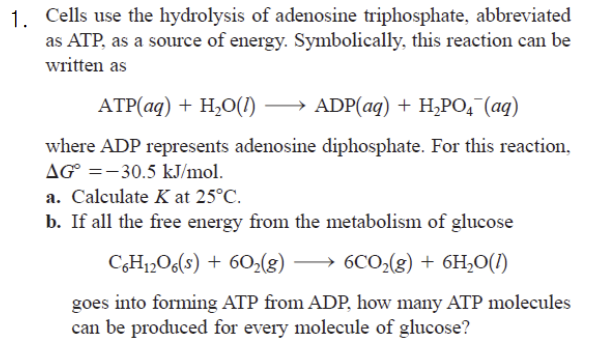cells use the hydrolysis of adenosine triphosphate, abbreviated as ATP, as a source of energy. Symbolically, this reaction can be written as ATP(aq) + H2O(l)--> ADP(aq) + H2PO4-(aq). where ADP represent adenosine diphosphate. For this reaction, ΔG∘=-30.5kj/mol. a. If all the free energy from the metabolism of glucose goes into forming ATP from ADP, how many ATP molecules can be produced for every molecule of glucose? C6H12O6 + 6O2 → 6CO2 + 6H2O
cells use the hydrolysis of adenosine triphosphate, abbreviated as ATP, as a source of energy. Symbolically, this reaction can be written as ATP(aq) + H2O(l)--> ADP(aq) + H2PO4-(aq). where ADP represent adenosine diphosphate. For this reaction, ΔG∘=-30.5kj/mol. a. If all the free energy from the metabolism of glucose goes into forming ATP from ADP, how many ATP molecules can be produced for every molecule of glucose? C6H12O6 + 6O2 → 6CO2 + 6H2O
Chemistry
10th Edition
ISBN:9781305957404
Author:Steven S. Zumdahl, Susan A. Zumdahl, Donald J. DeCoste
Publisher:Steven S. Zumdahl, Susan A. Zumdahl, Donald J. DeCoste
Chapter17: Spontaneity, Entropy, And Free Energy
Section: Chapter Questions
Problem 81E: Cells use the hydrolysis of adenosine triphosphate, abbreviated as ATP, as a source of energy....
Related questions
Question
cells use the hydrolysis of adenosine triphosphate, abbreviated as ATP, as a source of energy. Symbolically, this reaction can be written as ATP(aq) + H2O(l)--> ADP(aq) + H2PO4-(aq).
where ADP represent adenosine diphosphate. For this reaction, ΔG∘=-30.5kj/mol.
a. If all the free energy from the
C6H12O6 + 6O2 → 6CO2 + 6H2O

Transcribed Image Text:1. Cells use the hydrolysis of adenosine triphosphate, abbreviated
as ATP, as a source of energy. Symbolically, this reaction can be
written as
ATP(aq) + H₂O(1) →→→ ADP(aq) + H₂PO4¯ (aq)
where ADP represents adenosine diphosphate. For this reaction,
AG =-30.5 kJ/mol.
a. Calculate K at 25°C.
b. If all the free energy from the metabolism of glucose
C6H₁2O6(s) + 60₂(g)
6CO₂(g) + 6H₂O(1)
goes into forming ATP from ADP, how many ATP molecules
can be produced for every molecule of glucose?
Expert Solution
This question has been solved!
Explore an expertly crafted, step-by-step solution for a thorough understanding of key concepts.
Step by step
Solved in 2 steps with 2 images

Knowledge Booster
Learn more about
Need a deep-dive on the concept behind this application? Look no further. Learn more about this topic, chemistry and related others by exploring similar questions and additional content below.Recommended textbooks for you

Chemistry
Chemistry
ISBN:
9781305957404
Author:
Steven S. Zumdahl, Susan A. Zumdahl, Donald J. DeCoste
Publisher:
Cengage Learning

Chemistry: An Atoms First Approach
Chemistry
ISBN:
9781305079243
Author:
Steven S. Zumdahl, Susan A. Zumdahl
Publisher:
Cengage Learning


Chemistry
Chemistry
ISBN:
9781305957404
Author:
Steven S. Zumdahl, Susan A. Zumdahl, Donald J. DeCoste
Publisher:
Cengage Learning

Chemistry: An Atoms First Approach
Chemistry
ISBN:
9781305079243
Author:
Steven S. Zumdahl, Susan A. Zumdahl
Publisher:
Cengage Learning


Chemistry: The Molecular Science
Chemistry
ISBN:
9781285199047
Author:
John W. Moore, Conrad L. Stanitski
Publisher:
Cengage Learning

General Chemistry - Standalone book (MindTap Cour…
Chemistry
ISBN:
9781305580343
Author:
Steven D. Gammon, Ebbing, Darrell Ebbing, Steven D., Darrell; Gammon, Darrell Ebbing; Steven D. Gammon, Darrell D.; Gammon, Ebbing; Steven D. Gammon; Darrell
Publisher:
Cengage Learning

Chemistry & Chemical Reactivity
Chemistry
ISBN:
9781337399074
Author:
John C. Kotz, Paul M. Treichel, John Townsend, David Treichel
Publisher:
Cengage Learning